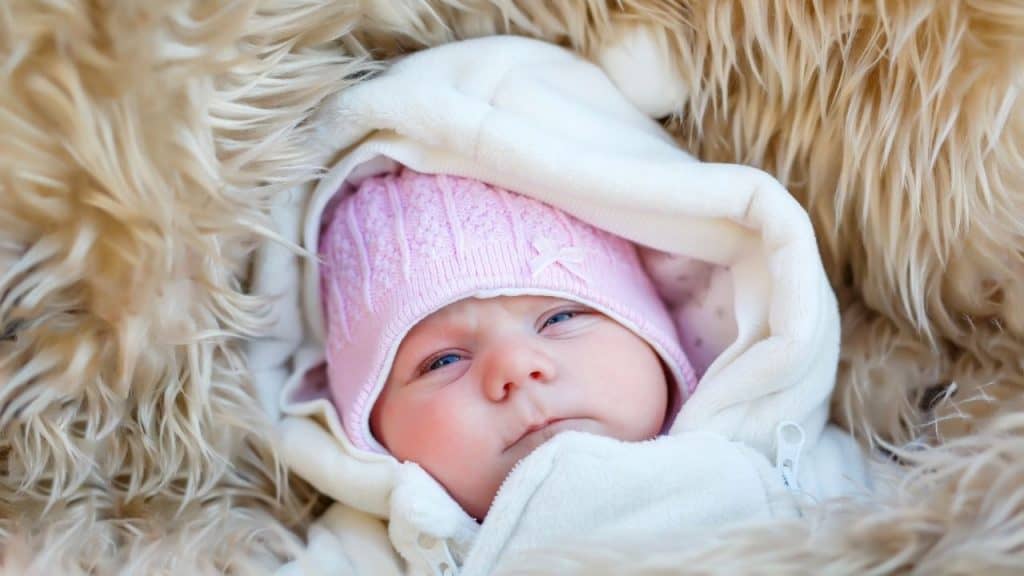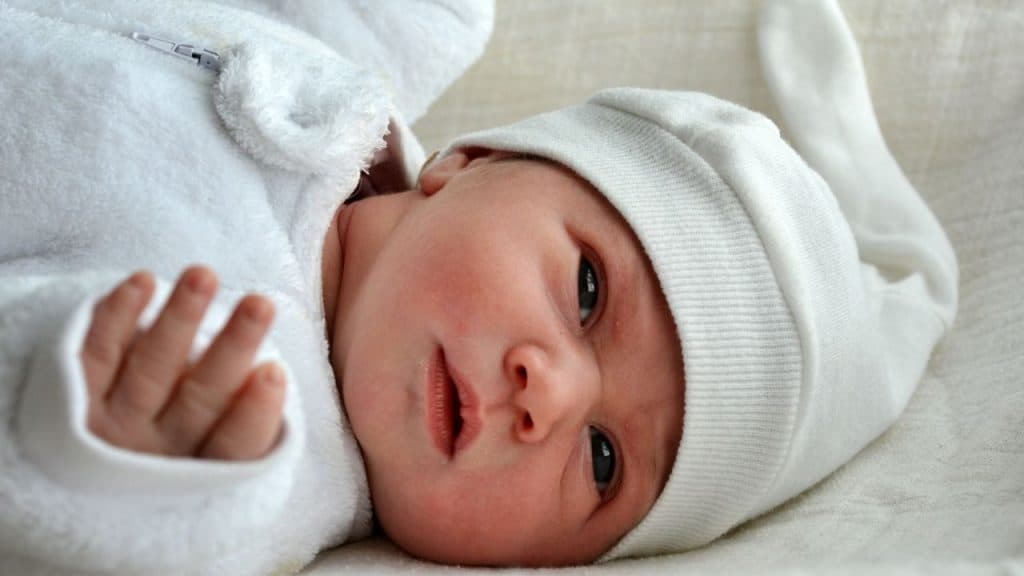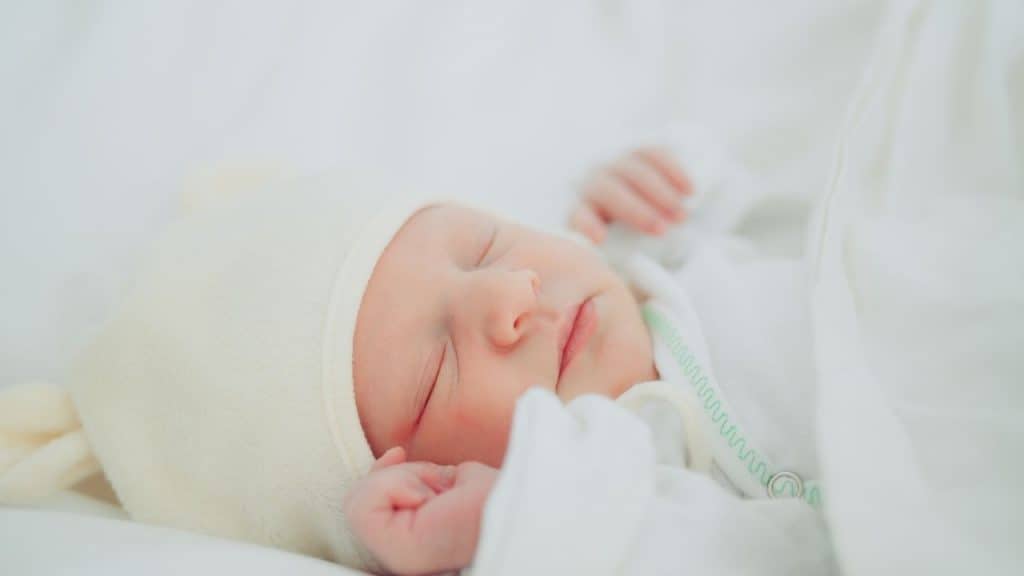It’s important to ensure your baby keeps warm in the crib because babies can’t control their body temperature as well as adults do. And since they can’t do much to rectify the issue themselves, it’s up to you to make sure your baby is not too warm or too cold while napping and sleeping.
There are many variables that parents can control and should be aware of in order to help babies stay warm while sleeping. Let’s take a look at them.

Here are the best ways to keep your baby warm in the crib during cold nights:
- Dress your baby appropriately
- Cover your baby’s hands
- Use a swaddle or sleep sack
- Monitor the temperature and humidity in the room
- Ensure proper room layout
- Check the outside temperature
- Observe your baby
Let’s look at how to address each of these tips.
Dress baby for sleep
In the summer, keep your little one from getting too warm by dressing him in light, airy clothing, such as a footed cotton sleeper. If you don’t have air conditioning, a diaper with or without a T-shirt is often enough in the hot summer months
To keep baby warm at night in the crib during the winter months, clothe your baby in layers. An undershirt with a snuggly fitted fleece sleeper will do the trick.
How many layers should you use? Use no more than one extra layer than you would need to be comfortable in the room’s temperature.
If your baby sleeping in a swaddle, don’t forget to count it as a layer as well.
Cover baby’s hands
Nobody is comfortable when their hands are freezing, which means your baby might get especially grumpy if you forget to cover his hands in cold weather. Soft, finely woven mittens work best, but you can also use a pair of your baby’s socks in a pinch.
If you notice your baby has cold hands at night you can use baby mittens or even socks to cover his hands.
Covering your baby’s hands has an added benefit, too! It keeps them from scratching at their face and injuring their delicate skin. While you can cover your baby’s hands and feet, never put them to sleep with any sort of head covering or cap, according to the American Academy of Pediatrics.
Use a Swaddle or Sleepsack
If you absolutely cannot bring yourself to put your baby in the crib without any covering other than his clothes, you can swaddle him or place him in a sleepsack. Swaddling is a blanket wrapping technique that keeps your baby cozy and safe while mimicking the conditions of the womb.
Keep in mind you should never swaddle a baby that can roll onto his stomach. Once your baby can roll over on his own, opt for a sleepsack or a swaddling technique where the arms are free..
Set and monitor for optimal room temperature
The perfect nursery temperature is between 65F and 72F, says Sleep Advisor. So set your thermostat accordingly.
Keep in mind that the reading on your central thermostat does not tell you how warm all the rooms in your house are. It only measures the temperature in the direct vicinity of the thermostat, which means the baby room temperature could be quite different.

To get a good reading on the temperature in your baby’s room, place a thermometer in the room near the crib and monitor it periodically. Adjust your thermostat as needed.
Humidity Level in the Room
Humidity can make a room feel warmer or colder. People and babies feel better in an environment with a relative humidity level between 30 and 50 percent. Remember, high humidity makes you feel warmer and low humidity makes you feel colder.
To raise the humidity in your baby’s room, use a humidifier. If there’s too much humidity, your baby feels sticky or clammy to the touch, use an air conditioner or dehumidifier to remove excess moisture from the air.
Plan the Room Layout
The room layout may also affect your ability to keep baby warm in the crib at night. Drafts, HVAC vents, poor insulation and even the amount of sun your baby’s room gets can all create hot and cold spots in the nursery. Therefore, it’s important to understand the temperature variances in your baby’s room and design the room appropriately.
Avoid placing the crib near a window or under a vent. The center of the room and the portion of the room that is closer to the interior of the home are often the most stable temperature wise. Outside walls can be chilly, so avoid these.
Vent Placement and Setting
Pay attention to where the vents are in your baby’s room. Also, check to see how open they are. If the room is too hot when the heat is running, you may be able to adjust the vent setting to rectify the issue.
Season and Outdoor Temperature
The outdoor temperature can dramatically affect the comfort level in your home. Not only does the weather affect the temp in your home, it affects the humidity level in your home. Higher outdoor temps along with high humidity will make the baby’s room feel warmer than the thermostat reading. The opposite is also true. Cold weather and dry air can make a room feel chilly even when the room temp is reasonable.
So, how do you know when your baby feels warmer or colder than the room temp? Pay attention to his appearance. If he is flushed and sweaty, he is hot. Take off a layer. Bluish hands and feet mean your baby is chilled and needs some more clothing.
Stay warm and safe in the crib
Tragically, about 3,500 children die in the United States each year from suffocation incidents while sleeping. This is why you should never place any objects in the crib or bassinet with your baby, including pillows, toys, quilts, blankets or any other bed gear (like bumper guards) that can press against your baby’s nose and obstruct his breathing.

Outfit his crib with a breathable, age-appropriate mattress cover over a firm mattress. Although it may seem uncomfortable to you, a firm mattress will not pose a suffocation risk if your baby finds himself in a sleeping position where his face is pressed into the bed.
Observe your baby for signs of discomfort
If you think your baby might be too cold or too hot, observe him. If needed touch his forehead, cheeks or hands. If you find that baby is getting hot, simply remove a layer.
Keeping baby warm for sleep FAQs
Here are some other commonly asked questions related to keeping a baby warm in the crib while sleeping.
What’s the Ideal Room Temperature?
The ideal room temperature is anything between 65 and 72 degrees Fahrenheit. The number that feels most comfortable to your baby will depend on if he tends to run a little hot or a little cold. If your baby tends to be a bit sweaty when everyone else is comfortable, clothe him in one layer less than you have on. If he tends to stay cold, put on an extra layer.
Can you Cover Baby with a Blanket?
No! Covering your baby with a blanket can increase his risk of sudden infant death syndrome (SIDS). Babies less than 12 months of age should sleep in a crib alone without any blankets, toys and crib accessories.
Once your baby turns 1, you can place a blanket in the crib. But you have to be careful about the type of blanket you use. A light, breathable blanket is best because your baby will still be able to breathe if he becomes trapped under it. Aso, never use a blanket with cords, ribbons or strings on it, as these can choke your baby.
Can Baby Sleep on a Heating Pad?
Your baby’s skin is sensitive and can burn easily. Temperatures that feel comfortable to you can actually be too hot for a baby. For this reason, you should never use a heating pad, hot water bottle or heated blanket to put your baby to sleep.
Rely on proper clothing to keep your baby warm. If your baby needs an extra layer, opt for a loose-fitting sleepsack placed over his pajamas.
Do Babies Sleep Better in a Cold Room?
When it’s too hot, babies sleep fitfully or not at all. The same is true when it’s too cold. The ideal room temperature is the one that your baby feels the most comfortable in and sleeps the best in. Since all babies are different, this may take some trial and error to figure out.
If your baby is too hot, turn on a fan or lower the thermostat by a degree or two. If your baby is too cold, put on another layer, thicker pajamas, or use a sleepsack. Always strive to keep your baby at their ideal temperature and help him have a safe sleep.
Paul is a passionate dad who founded Upside Dad to share his parenting journey with other new parents. He graduated from Concordia University and worked as a test engineer for over a decade. Paul loves dad jokes and craft beer.
Learn more about Paul and Upside Dad here.
